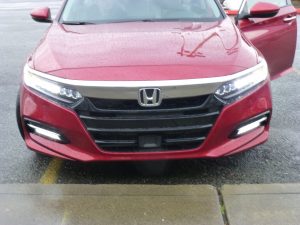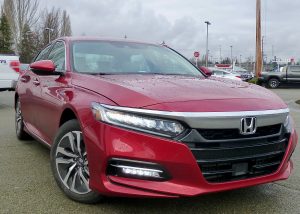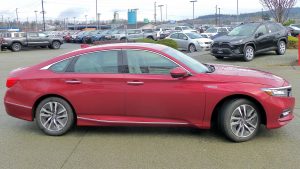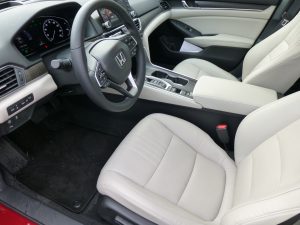Accord Hybrid Over-Runs Demands of Family Sedan
By John Gilbert
BELLINGHAM, WASH.
My first after-Christmas auto review was going to be on the 2019 Honda Accord Hybrid, with the spectacular backdrop of the Pacific Northwest and Mount Baker. But that was before I got carried away describing the life-saving performance of our family Mini Cooper, making it home from Minneapolis to Duluth in a 6-hour battle against ice and whiteout conditions.
There’s still time. We can go back and evaluate the Accord Hybrid, but I must admit to being distracted by the spectacular scenery. No, not distracted driving; we stopped to admire the breathtaking views.
Without a doubt, the new Accord makes a strong impression, whether looking at it, riding in it, or driving. The EPA estimates for gas mileage is 47 miles per gallon city, 47 highway, and 47 combined. Makes sense. The Accord also performs with a strong, sporty flair that parallels the new looks.
The tenth generation Honda Accord came out as a 2018 model, and it is a curvaceous, attractive sedan that seems bigger than midsize. With styling cues from the exotic NSX sports car, the virtually unchanged 2019 stops folks in their tracks with its looks, especially from the front, where its thin string of LED headlights underscores the exotic appearance.
You could say this isn’t your daddy’s Accord, except that I was playing the daddy role during the trip.
I got a chance to test drive the new Accord Hybrid on our family’s Christmas trip to the Seattle-Bellingham areas of Washington, and several things jumped out at us immediately. First, there is enough room in the rear seat to hold a small convention, and the roominess is better than some large cars.

Stunning sunsets illuminate the shadows of Bellingham’s harbor and the San Juan Islands off to the West.
Second, there is considerable power from the hybrid system, which has a combination of a 2.0-liter VTEC 4-cylinder engine and a rechargeable electric motor device that, combines, produces 212 horsepower. I have no doubt the Accord Hybrid could have handled our venture from Bellingham up to the ski stations at the top of Mount Baker, but since the area had just been hit by over 2 feet of snow, we would be wiser to make the trek in younger son Jeffrey’s 4×4 Tacoma pickup.
The third noteworthy feature was that Honda is going with a continuously variable transmission, an electrically operated unit that uses belts and pulleys to enlarge or diminish in a system of never-shifting but always-shifting. CVTs have the nagging tendency of droning like a one-speed outboard instead of the stepped peaks of a normal automatic transmission. Honda wisely adds paddle shifters on the steering wheel to allow the driver to simulate manually controlled shifts and alleviate some of that inherent boredom.
I would grade Honda’s effort at B-, for at least trying to make it sporty.
The best part of a hybrid is to approach the spirit of a gasoline engine and provide a large increase in fuel economy from the electric motor input, knowing that the gas engine can spend its spare time recharging the electrical power.
Going back a couple of decades, to when Toyota and Honda were ferocious rivals to establish the major footprint on the hybrid market, Toyota had the Prius and Honda the Insight, and both tried to figure out how to turn their immensely popular midsize sedans into hybrids, so Honda put its system into the Accord, ahead of Toyota putting its system into the Camry.
It was fun talking to engineers of both companies, and I recall attending the earlier Accord Hybrid introduction when I questioned the engineers about why — when the gas engine’s primary duty is to recharge the battery pack — Honda didn’t use its exceptional 4 instead of the larger V6. They had their reasons, but I followed by asking what would happen if Toyota used its 4 with the hybrid when the Camry came out. That’s what happened, and when the Camry flashed better fuel economy, Honda was quick to discontinue the Accord Hybrid.
Hybrid technology has advanced all along, and the newest hybrids are remarkable in their smoothness and performance. Plug-in hybrids are even more efficient, and a logical step up as we transition toward all-electric vehicles. German hybrids from Audi, BMW and Mercedes have made their mark, and Hyundai has made amazing strides with among the highest technology in hybrids with the Ioniq and Sonata sedans, and the new Kona CUV.
Honda’s strategy is to bring out a newly designed Insight, while powering the rear wheels of its exotic NSX with electric motors, and bring back the Accord as a hybrid model. Most impressive, given that history, is that the new 2019 Accord Hybrid uses the potent corporate 2.0 4-cylinder engine to work with the electric power.
Because hybrid power is most efficient in stop and go traffic, city miles per gallon is usually higher than highway cruising — the opposite for gas-engine driving. Driving moderately can keep the gas mileage up near that magical 50 mark, and you certainly could top it with extra care.
When driving a hybrid, you want to let off the gas before needing to clamp hard on the brakes, and easing the brakes on for a slow stop enhances the recharging characteristics. Same with going down hills. In Duluth, for example, you might use a lot of available power zooming up the hills, but you also can recover a lot by braking lightly as you come back down.
The next most impressive thing about the Accord Hybrid is that it comes in a pretty loaded form, so no added options were necessary on our test vehicle, which had a bottom-line sticker of $35,605, decidedly reasonable because the standard roomy Accord sedan would cost just about the same, with the same features.
Those features include all the current items: rear camera, cross-traffic alert, lane keeping and lane departure assist, road-leaving mitigation, collision mitigation, remote start, front and rear parking sensors, and adaptive cruise. And it also adds some features that are pretty unique. Twelve-way power driver seat should keep you alert, but there also is a driver attention monitor to help keep you tuned in. Another is “walk-away locks,” which I wasn’t familiar with. But when we left the car unlocked briefly and came back to find it had locked itself, I was impressed. Honda always has been adept at unobtrusively making cars idiot-proof.

New-generation style, plus increased air-intake for hybrid engine cooling give Accord a distinctive look.
Honda always has been at the forefront of great handling and steering, too, and the Accord Hybrid takes that to a new level, with firm suspentsion and precise, line-carving trajectory around curves making full use of the well-tuned MacPherson strut front and multi-link rear suspension, and proving it is possible to coordinate electric steering and shift control.
It would take longer than we had to get comfortable with tuning tricks for the audio system, where Honda seems to have subscribed to rivals who make the simple tasks that used to be operated by round knobs for volume and selection needlessly complex.
Wherever you look, though, you realize that if you just bought a contemporary, roomy 4-door sedan, you could pay $35,000; if you bought a different vehicle with a contemporary hybrid system, you could easily pay $35000. The Accord Hybrid gives you both — a roomy super-sedan that is quick and handles well, and a hybrid powertrain that meets all requirements and delivers exceptional economy.





 John Gilbert is a lifetime Minnesotan and career journalist, specializing in cars and sports during and since spending 30 years at the Minneapolis Tribune, now the Star Tribune. More recently, he has continued translating the high-tech world of autos and sharing his passionate insights as a freelance writer/photographer/broadcaster. A member of the prestigious North American Car and Truck of the Year jury since 1993. John can be heard Monday-Friday from 9-11am on 610 KDAL(www.kdal610.com) on the "John Gilbert Show," and writes a column in the Duluth Reader.
John Gilbert is a lifetime Minnesotan and career journalist, specializing in cars and sports during and since spending 30 years at the Minneapolis Tribune, now the Star Tribune. More recently, he has continued translating the high-tech world of autos and sharing his passionate insights as a freelance writer/photographer/broadcaster. A member of the prestigious North American Car and Truck of the Year jury since 1993. John can be heard Monday-Friday from 9-11am on 610 KDAL(www.kdal610.com) on the "John Gilbert Show," and writes a column in the Duluth Reader.